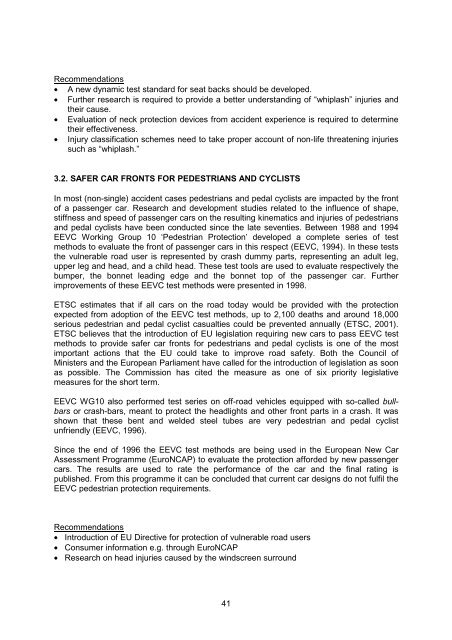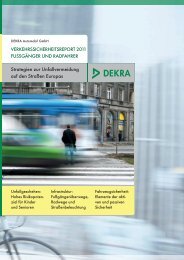PRIORITIES FOR EU MOTOR VEHICLE SAFETY DESIGN
priorities for eu motor vehicle safety design - ETSC
priorities for eu motor vehicle safety design - ETSC
Create successful ePaper yourself
Turn your PDF publications into a flip-book with our unique Google optimized e-Paper software.
Recommendations<br />
• A new dynamic test standard for seat backs should be developed.<br />
• Further research is required to provide a better understanding of “whiplash” injuries and<br />
their cause.<br />
• Evaluation of neck protection devices from accident experience is required to determine<br />
their effectiveness.<br />
• Injury classification schemes need to take proper account of non-life threatening injuries<br />
such as “whiplash.”<br />
3.2. SAFER CAR FRONTS <strong>FOR</strong> PEDESTRIANS AND CYCLISTS<br />
In most (non-single) accident cases pedestrians and pedal cyclists are impacted by the front<br />
of a passenger car. Research and development studies related to the influence of shape,<br />
stiffness and speed of passenger cars on the resulting kinematics and injuries of pedestrians<br />
and pedal cyclists have been conducted since the late seventies. Between 1988 and 1994<br />
EEVC Working Group 10 ‘Pedestrian Protection’ developed a complete series of test<br />
methods to evaluate the front of passenger cars in this respect (EEVC, 1994). In these tests<br />
the vulnerable road user is represented by crash dummy parts, representing an adult leg,<br />
upper leg and head, and a child head. These test tools are used to evaluate respectively the<br />
bumper, the bonnet leading edge and the bonnet top of the passenger car. Further<br />
improvements of these EEVC test methods were presented in 1998.<br />
ETSC estimates that if all cars on the road today would be provided with the protection<br />
expected from adoption of the EEVC test methods, up to 2,100 deaths and around 18,000<br />
serious pedestrian and pedal cyclist casualties could be prevented annually (ETSC, 2001).<br />
ETSC believes that the introduction of <strong>EU</strong> legislation requiring new cars to pass EEVC test<br />
methods to provide safer car fronts for pedestrians and pedal cyclists is one of the most<br />
important actions that the <strong>EU</strong> could take to improve road safety. Both the Council of<br />
Ministers and the European Parliament have called for the introduction of legislation as soon<br />
as possible. The Commission has cited the measure as one of six priority legislative<br />
measures for the short term.<br />
EEVC WG10 also performed test series on off-road vehicles equipped with so-called bullbars<br />
or crash-bars, meant to protect the headlights and other front parts in a crash. It was<br />
shown that these bent and welded steel tubes are very pedestrian and pedal cyclist<br />
unfriendly (EEVC, 1996).<br />
Since the end of 1996 the EEVC test methods are being used in the European New Car<br />
Assessment Programme (EuroNCAP) to evaluate the protection afforded by new passenger<br />
cars. The results are used to rate the performance of the car and the final rating is<br />
published. From this programme it can be concluded that current car designs do not fulfil the<br />
EEVC pedestrian protection requirements.<br />
Recommendations<br />
• Introduction of <strong>EU</strong> Directive for protection of vulnerable road users<br />
• Consumer information e.g. through EuroNCAP<br />
• Research on head injuries caused by the windscreen surround<br />
41



